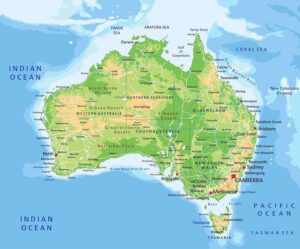At the Asia Society in New York is an amazing exhibition of art works on eucalyptus bark done in the Arnhem area of Northern Australia by members of two neighboring clans who find painting their designs to be a sacred practice. They call this effort Madayin in their indigenous language. With enormous effort, a bilingual catalog of 347 pages explains each work and the meaning of same to each artist. Their works are shown in an art center which is 450 miles east of Darwin named “buku-larrngay” which means “the feeling on your face as it is struck by the first rays of the sun.“
This effort is the result of cooperation with a museum on the campus of the University of Virginia endowed with aboriginal paintings and funds from the estate of John Kluge who was a German American mogul who sold his stock in Metropolitan Broadcasting in 1986 to 20th Century Fox for $4 billion dollars. He loved the art of Australia, and this museum has housed his entire collection of 2200 works since his death in 2010. Former Australian Prime Minister Kevin Rudd hosted the leaders of both tribes, the Yirritja and Dhuwa Clans, in New York in 2017 to begin the process of putting the show together with the director of the Kluge-Ruhe Aboriginal Art Collection at the University of Virginia, Margo Smith.
The process of painting on eucalyptus bark is a complex one involving drying the bark in the sun, coating it with a primer to seal all cracks, then applying the artists design with a brush made of human hair.
Here we can see images of the artist, his wife and two sons amidst the flora and fauna of their area. Primitive tools are used to capture animals for consumption, and the hunts themselves become family events. This bark painting measures 75 by 42 inches and is on loan for this Asia Society show.
This more contemporary work by the son of the first artist above, shows the use of natural polymer pigments on the bark to add more color to the composition. We can see the artist below in his boat accompanied by three others trying to catch fish, octopus, and starfish in the oceans near the northern coast.
In 2000, my husband and I visited Australia on a business trip and were able to purchase a work of art by a female aboriginal artist named Queenie McKenzie. She lived in East Kimberley in western Australia and painted this portrait of her village using sand, blood, dirt, and urine with a yellow binder. On canvas, it was an easier surface on which to use such a complex mix of elements. She has passed away, and we treasure her work in our home to this day.
One aboriginal poem expresses the vigor of this kind of artwork and how much it means to the people in this region of the world:
The water of knowledge springs from beneath the earth,
Calling out the sacred names of the clan where we came ashore
To begin our journey from the spirit land.
Wanyubi Marika, Dhuwa Clan.
The Asia Society is open five days a week from 11 am to 5 pm and closed on Monday and Tuesdays. The website contains all the details of the many events associated with this exhibition: www.asiasociety.org. Each visitor needs plenty of time to see and examine each work of art as they are all very different and colorful in tone and technique.
725 Park Avenue, New York City September 17, 2024- January 5, 2025
Source consulted:
Madayin, Eight Decades of Aboriginal Australian Bark Painting from Yirrkala. Kluge- Ruhe Aboriginal Art Collection. Del Monica Books- DAP. New York, 2022.

